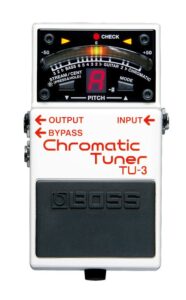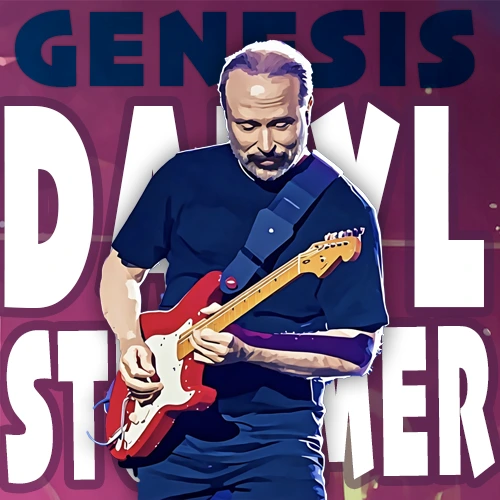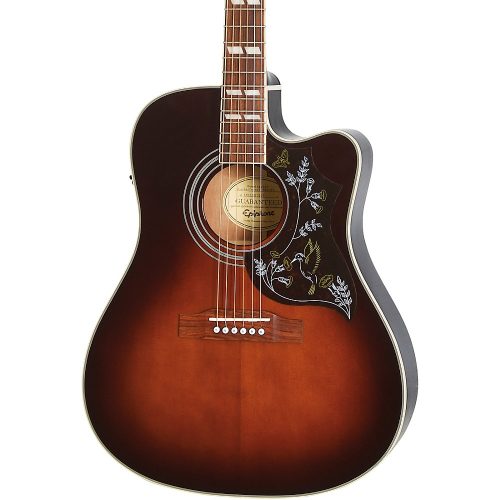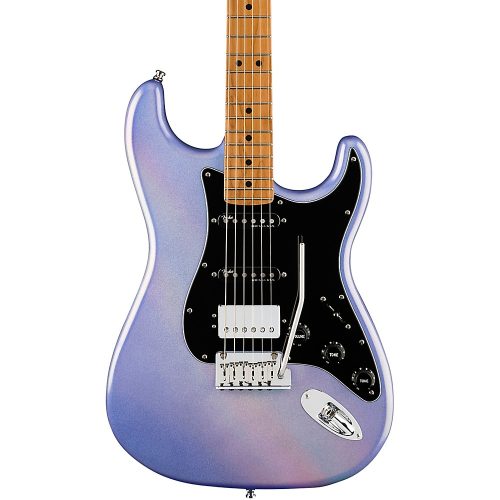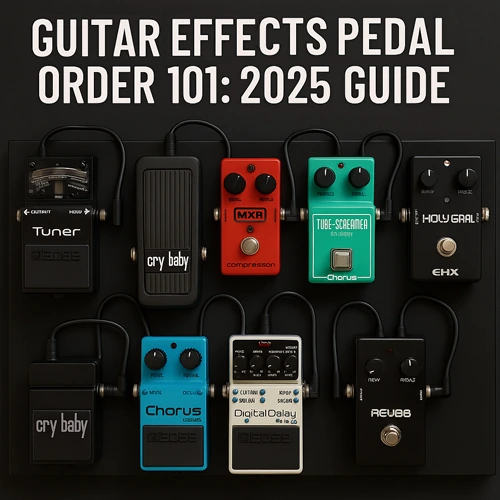
Table of Contents
Ever wonder why your pedalboard sounds like mud even though you’ve got quality gear? The answer usually comes down to one thing most guitarists overlook: pedal order. Your Boss DS-1 might sound killer, but put it after your delay and suddenly you’re fighting a wall of distorted echoes that would make even Kurt Cobain wince.
Here’s the thing – pedal order isn’t some mystical art form. It’s more like following a recipe. Get the sequence right, and each effect shines. Mess it up, and you’re stuck wondering why your rig sounds worse than a practice amp in a garage.
Why Guitar Effects Pedal Order Can Make or Break Your Tone
Your guitar signal travels through each pedal like water through a pipe. Each stompbox processes whatever signal it receives from the previous pedal. Put a chorus before your Tube Screamer, and the overdrive will distort the modulated signal, creating a messy warble instead of that smooth, singing sustain you’re after.
As one Reddit user put it perfectly:
“If you’ve got a vintage-style fuzz (a Tonebender or Fuzz Face style), it wants to go first in line because they need to have a direct connection with your pickups to sound best.”
This isn’t about following rules for the sake of rules. It’s about understanding how each pedal affects your signal so you can get the sounds you hear in your head coming out of your amp.
The Foundation: Standard Guitar Effects Pedal Order
Most pros start with this proven signal chain:
Guitar → Tuner → Wah/Filter → Compressor → Overdrive/Distortion → Modulation → Delay → Reverb → Amp
The Signal Chain Breakdown
| Position | Effect Type | Why It Goes Here | Popular Examples |
|---|---|---|---|
| 1 | Tuner | Needs pure signal for accuracy | Boss TU-3, TC Polytune |
| 2 | Wah/Filter | Works best on clean guitar signal | Dunlop Cry Baby, Vox V847 |
| 3 | Compressor | Evens dynamics before distortion | MXR Dyna Comp, Boss CS-3 |
| 4 | Overdrive/Distortion | Core tone generation | Tube Screamer, Boss DS-1 |
| 5 | Modulation | Adds movement to distorted tone | Boss CE-2, MXR Phase 90 |
| 6 | Delay | Repeats your shaped tone | Boss DD-8, MXR Carbon Copy |
| 7 | Reverb | Final ambience layer | Boss RV-6, EHX Holy Grail |
Tuner Pedals: Always First
Your tuner reads pitch, and it needs the cleanest possible signal to do its job right. Any processing before the tuner – whether it’s a Big Muff’s fuzz or a Memory Man’s delay – will confuse the circuitry and make tuning a nightmare.
The Boss TU-3 became the standard because it’s bulletproof and accurate. The TC Electronic Polytune lets you strum all six strings at once for quick tuning checks between songs.
Wah and Filter Pedals: Early and Clean
Wah pedals sweep through your guitar’s frequency spectrum. Feed them a clean signal, and you get that classic “wah” cry. Put them after distortion, and as one guitarist noted: “after distortion it sounds like a big crazy synth sweep.”
Both sounds have their place, but most players want the traditional wah response, which means placing it early in the chain.
Compressor Pedals Placement Strategy
Compressors even out your picking dynamics and add sustain. Place yours after the tuner and wah but before any distortion. This gives your drive pedals a consistent signal to work with and prevents the compressor from squashing an already-distorted signal into lifeless mush.
Country and funk players often rely heavily on compression for that snappy, articulate tone. Blues players sometimes use light compression to add sustain without losing natural dynamics. Indie and alternative guitarists might use compression to even out clean arpeggios or add punch to rhythm parts. Metal players might skip it entirely since high-gain distortion naturally compresses the signal.
Drive Pedal Stacking: The Heart of Your Guitar Effects Pedal Order
Drive pedals are the effects that add grit, distortion, and saturation to your guitar signal. This family includes clean boosts, overdrives, distortions, and fuzz pedals – basically anything that makes your guitar sound “dirtier” or more aggressive than the clean signal coming straight from your pickups.
Think of drive pedals as the difference between a gentle push and a hard shove. A clean boost gives your signal a gentle nudge, an overdrive pushes it into warm saturation, distortion shoves it into aggressive clipping, and fuzz completely mangles it into fuzzy chaos.
Here’s where things get interesting. Multiple drive pedals need careful ordering to avoid a muddy mess.
The Low-to-High Gain Rule
Stack your drives from lowest gain to highest gain. Start with a clean boost or light overdrive, then move to medium distortion, and finish with heavy fuzz if you use one.
Example Drive Stack:
- Clean boost (Xotic EP Booster)
- Light overdrive (Ibanez TS-808)
- Medium distortion (Boss DS-1)
- Heavy fuzz (EHX Big Muff)
This gives you smooth transitions and lets you push each pedal with the previous one for solos or heavier sections.
Special Case: Fuzz Pedals
Vintage fuzz circuits are picky about placement. Many sound best first in the entire chain, even before the tuner. They interact directly with your guitar’s pickups and don’t play well with buffers or other active electronics.
If your fuzz has true bypass, you can keep the tuner first and place the fuzz second. But if it’s not true bypass or seems to lose character after other pedals, try putting it right up front (just switch it off when tuning).
Modulation Effects: Adding Movement
Chorus, phaser, flanger, and tremolo pedals typically go after your drive section. This placement lets the modulation sit clearly on top of your distorted tone instead of getting buried or creating unwanted artifacts.
Common Modulation Order
| Pedal Type | Best Placement | Sound Character |
|---|---|---|
| Phaser | Position 5 (after overdrive/distortion) | Sweeping filter effect on distorted tone |
| Chorus | Position 5 (after overdrive/distortion) | Doubling/shimmer effect on shaped tone |
| Flanger | Position 5 (after overdrive/distortion) | Jet engine swoosh over distorted signal |
| Tremolo | Position 5 (after overdrive/distortion) | Volume pulsing of complete tone |
Breaking the Rules: Modulation Before Drives
Some players prefer certain modulation effects before distortion. Eddie Van Halen famously ran his MXR Phase 90 before his cranked Marshall for a more integrated, vintage sweep that became part of his lead tone rather than sitting on top of it.
Experiment with both placements to find what works for your style.
Time-Based Effects: The Final Polish
Delay and reverb come last because they add space and ambience to your fully-formed tone.
Delay Pedal Placement
Delay pedals capture whatever signal they receive and repeat it. Place delay at the end of your chain, and you get clean repeats of your complete tone. Put it before distortion, and each repeat gets progressively more distorted and chaotic – great for experimental music, terrible for most rock applications.
Popular Delay Types:
- Digital delays (Boss DD series): Clean, precise repeats
- Analog delays (MXR Carbon Copy): Warm, degrading repeats
- Tape echo emulations (Boss RE-202): Vintage character with flutter
Reverb: The Final Touch
Reverb simulates acoustic space and typically goes last in the chain. Think about it – in real life, reverb is the last thing that happens to sound before it reaches your ears.
Most players prefer delay before reverb so the echoes decay naturally into the reverb wash. Some ambient players flip this order for specific textures, but delay-first is the safer starting point.
Advanced Strategies: Using Your Amp’s Effects Loop
If your amp has an effects loop, you can split your pedals for better tone quality.
Front of Amp vs. Effects Loop
Front of Amp (Input):
- Tuner
- Wah
- Compressor
- All drive pedals
- Boost pedals
Effects Loop (Send/Return):
- Modulation effects
- Delay
- Reverb
- EQ pedals
This prevents your amp’s preamp distortion from muddying up your modulation and time-based effects. The loop sits between the preamp and power amp, so effects in the loop stay clean even with a cranked preamp.
The Four-Cable Method
For maximum flexibility:
- Guitar to pedals to amp input (tone-shaping effects)
- Amp send to more pedals to amp return (ambience effects)
This setup gives you the best of both worlds: natural amp breakup with crystal-clear effects.
Effects Loop Beginner Tips
If you’re new to effects loops, start simple. Use just one pedal (like a delay) in the loop first to get comfortable with the extra cables. Watch your signal levels – some pedals might be too loud or quiet in the loop compared to the front of the amp. Most modern pedals handle loop levels fine, but if something sounds thin or distorted in the loop, try adjusting the pedal’s output level or your amp’s loop return control.
Genre-Specific Guitar Effects Pedal Order Variations
Different musical styles often require tweaks to the standard order:
Blues and Classic Rock Setup
- Keep it simple: Tuner → Wah → Overdrive → Amp
- Maybe add subtle delay and reverb
- Focus on amp breakup with overdrive boost
Metal and High-Gain Configurations
- Add noise gates after drive pedals
- Use overdrive as boost into high-gain amp
- EQ pedals for tone sculpting (often in effects loop)
- Minimal delay/reverb to maintain attack clarity
Ambient and Experimental Approaches
- Multiple delays and reverbs
- Volume pedals for swells
- Breaking conventional order for texture
- Loopers to layer sounds
Common Guitar Effects Pedal Order Mistakes
Putting Time Effects Before Distortion
This creates muddy, chaotic repeats unless you specifically want that experimental texture.
Compressing Already-Distorted Signals
Placing compressors after high-gain pedals often results in lifeless, over-processed tone.
Ignoring Impedance Issues
Vintage fuzz pedals and certain effects need proper impedance matching to sound their best.
Power Supply Problems
Digital pedals especially need clean, isolated power to prevent noise and ensure proper operation.
Essential Pedal Brands and Typical Placement
Understanding common pedals helps when building your rig:
- TU-3 Tuner: Always first
- BD-2 Blues Driver: Gain section
- CE-2 Chorus: Modulation section
- DD-8 Delay: End of chain
- Big Muff Fuzz: Early in gain section
- POG Octave: After tuner, before gain
- Holy Grail Reverb: End of chain
- Phase 90: Modulation (or before gain for vintage vibe)
- Carbon Copy Delay: End of chain
- Cry Baby Wah: After tuner, before gain
Building Your Perfect Signal Chain
Start Simple
Begin with tuner, one drive pedal, and one time effect. Get this basic chain working perfectly before adding complexity.
Experiment Methodically
Try moving one pedal at a time to hear the difference. This hands-on experience teaches you more than any guide.
Consider Practical Factors
Cable lengths, power requirements, and switching convenience matter as much as tone in live situations.
Guitar Effects Pedal Order – Interactive Chart
🎸 Find Your Ideal Pedal Chain
Click a tone to see the pedal order that creates it
Guitar Effects Pedal Order – FAQs
Q: Where should my volume pedal go? A: Early in the chain (after tuner) acts like your guitar’s volume knob. Later (after drives) works as master volume for swells.
Q: Can I put reverb before delay? A: Yes, though it’s less common. Creates repeats of the reverb wash – ethereal for ambient music, potentially muddy for rock.
Q: Do I need a buffer? A: With many true-bypass pedals and long cables, yes. Signs include high-end loss and reduced output level.
Q: Should EQ go before or after drives? A: After drives sculpts your distorted tone. Before drives shapes what hits your gain pedals. Both work for different purposes.
Q: Does pedal order matter differently for digital vs. analog pedals? A: The basic order principles apply to both, but there are some considerations. Analog pedals (like vintage fuzzes) are often more sensitive to what comes before them. Digital pedals usually handle different signal levels better and aren’t as picky about placement. Many players prefer analog effects early in the chain to preserve natural guitar dynamics, then use digital effects for complex modulation and delays at the end.
The Real Truth About Pedal Order
The standard order works because it’s been tested by thousands of guitarists across decades of music. But as one Reddit user wisely noted:
“There is no wrong way to do it. Any pedal order will work, but every combination will yield specific results.”
Learn the fundamentals first, then trust your ears when experimenting. Some of the most famous guitar tones came from players who broke the rules – either on purpose or by accident.
Your pedalboard should inspire you to play and help you achieve the sounds in your head. Use this guide as your foundation, but don’t be afraid to experiment. The “wrong” pedal order might just become your signature sound.
Whether you’re chasing Hendrix’s fuzz-into-Uni-Vibe setup, The Edge’s rhythmic delays, or creating your own ambient sounds, understanding signal chain basics gives you the tools to build whatever tone you can imagine.
👉 Check out more deals and gear reviews on the Get My Guitar Blog.
👉 Join our guitarist community to share your finds and discuss all things guitar!
👉 Check out the very latest Guitar News.
Disclosure: This post contains affiliate links. If you purchase through these links, we may earn a commission at no extra cost to you.
Recent Posts
Imagine this: it's 1980, and after a Genesis rehearsal, Phil Collins offers a Milwaukee guitarist a ride back into [...]
Ever wonder why your pedalboard sounds like mud even though you've got quality gear? The answer usually comes down [...]
Do you ever find yourself air-drumming to your favorite track and thinking, "Man, I need to be playing this [...]
Blog Categories
Tags

Table of Contents
Ever wonder why your pedalboard sounds like mud even though you’ve got quality gear? The answer usually comes down to one thing most guitarists overlook: pedal order. Your Boss DS-1 might sound killer, but put it after your delay and suddenly you’re fighting a wall of distorted echoes that would make even Kurt Cobain wince.
Here’s the thing – pedal order isn’t some mystical art form. It’s more like following a recipe. Get the sequence right, and each effect shines. Mess it up, and you’re stuck wondering why your rig sounds worse than a practice amp in a garage.
Why Guitar Effects Pedal Order Can Make or Break Your Tone
Your guitar signal travels through each pedal like water through a pipe. Each stompbox processes whatever signal it receives from the previous pedal. Put a chorus before your Tube Screamer, and the overdrive will distort the modulated signal, creating a messy warble instead of that smooth, singing sustain you’re after.
As one Reddit user put it perfectly:
“If you’ve got a vintage-style fuzz (a Tonebender or Fuzz Face style), it wants to go first in line because they need to have a direct connection with your pickups to sound best.”
This isn’t about following rules for the sake of rules. It’s about understanding how each pedal affects your signal so you can get the sounds you hear in your head coming out of your amp.
The Foundation: Standard Guitar Effects Pedal Order
Most pros start with this proven signal chain:
Guitar → Tuner → Wah/Filter → Compressor → Overdrive/Distortion → Modulation → Delay → Reverb → Amp
The Signal Chain Breakdown
| Position | Effect Type | Why It Goes Here | Popular Examples |
|---|---|---|---|
| 1 | Tuner | Needs pure signal for accuracy | Boss TU-3, TC Polytune |
| 2 | Wah/Filter | Works best on clean guitar signal | Dunlop Cry Baby, Vox V847 |
| 3 | Compressor | Evens dynamics before distortion | MXR Dyna Comp, Boss CS-3 |
| 4 | Overdrive/Distortion | Core tone generation | Tube Screamer, Boss DS-1 |
| 5 | Modulation | Adds movement to distorted tone | Boss CE-2, MXR Phase 90 |
| 6 | Delay | Repeats your shaped tone | Boss DD-8, MXR Carbon Copy |
| 7 | Reverb | Final ambience layer | Boss RV-6, EHX Holy Grail |
Tuner Pedals: Always First
Your tuner reads pitch, and it needs the cleanest possible signal to do its job right. Any processing before the tuner – whether it’s a Big Muff’s fuzz or a Memory Man’s delay – will confuse the circuitry and make tuning a nightmare.
The Boss TU-3 became the standard because it’s bulletproof and accurate. The TC Electronic Polytune lets you strum all six strings at once for quick tuning checks between songs.
Wah and Filter Pedals: Early and Clean
Wah pedals sweep through your guitar’s frequency spectrum. Feed them a clean signal, and you get that classic “wah” cry. Put them after distortion, and as one guitarist noted: “after distortion it sounds like a big crazy synth sweep.”
Both sounds have their place, but most players want the traditional wah response, which means placing it early in the chain.
Compressor Pedals Placement Strategy
Compressors even out your picking dynamics and add sustain. Place yours after the tuner and wah but before any distortion. This gives your drive pedals a consistent signal to work with and prevents the compressor from squashing an already-distorted signal into lifeless mush.
Country and funk players often rely heavily on compression for that snappy, articulate tone. Blues players sometimes use light compression to add sustain without losing natural dynamics. Indie and alternative guitarists might use compression to even out clean arpeggios or add punch to rhythm parts. Metal players might skip it entirely since high-gain distortion naturally compresses the signal.
Drive Pedal Stacking: The Heart of Your Guitar Effects Pedal Order
Drive pedals are the effects that add grit, distortion, and saturation to your guitar signal. This family includes clean boosts, overdrives, distortions, and fuzz pedals – basically anything that makes your guitar sound “dirtier” or more aggressive than the clean signal coming straight from your pickups.
Think of drive pedals as the difference between a gentle push and a hard shove. A clean boost gives your signal a gentle nudge, an overdrive pushes it into warm saturation, distortion shoves it into aggressive clipping, and fuzz completely mangles it into fuzzy chaos.
Here’s where things get interesting. Multiple drive pedals need careful ordering to avoid a muddy mess.
The Low-to-High Gain Rule
Stack your drives from lowest gain to highest gain. Start with a clean boost or light overdrive, then move to medium distortion, and finish with heavy fuzz if you use one.
Example Drive Stack:
- Clean boost (Xotic EP Booster)
- Light overdrive (Ibanez TS-808)
- Medium distortion (Boss DS-1)
- Heavy fuzz (EHX Big Muff)
This gives you smooth transitions and lets you push each pedal with the previous one for solos or heavier sections.
Special Case: Fuzz Pedals
Vintage fuzz circuits are picky about placement. Many sound best first in the entire chain, even before the tuner. They interact directly with your guitar’s pickups and don’t play well with buffers or other active electronics.
If your fuzz has true bypass, you can keep the tuner first and place the fuzz second. But if it’s not true bypass or seems to lose character after other pedals, try putting it right up front (just switch it off when tuning).
Modulation Effects: Adding Movement
Chorus, phaser, flanger, and tremolo pedals typically go after your drive section. This placement lets the modulation sit clearly on top of your distorted tone instead of getting buried or creating unwanted artifacts.
Common Modulation Order
| Pedal Type | Best Placement | Sound Character |
|---|---|---|
| Phaser | Position 5 (after overdrive/distortion) | Sweeping filter effect on distorted tone |
| Chorus | Position 5 (after overdrive/distortion) | Doubling/shimmer effect on shaped tone |
| Flanger | Position 5 (after overdrive/distortion) | Jet engine swoosh over distorted signal |
| Tremolo | Position 5 (after overdrive/distortion) | Volume pulsing of complete tone |
Breaking the Rules: Modulation Before Drives
Some players prefer certain modulation effects before distortion. Eddie Van Halen famously ran his MXR Phase 90 before his cranked Marshall for a more integrated, vintage sweep that became part of his lead tone rather than sitting on top of it.
Experiment with both placements to find what works for your style.
Time-Based Effects: The Final Polish
Delay and reverb come last because they add space and ambience to your fully-formed tone.
Delay Pedal Placement
Delay pedals capture whatever signal they receive and repeat it. Place delay at the end of your chain, and you get clean repeats of your complete tone. Put it before distortion, and each repeat gets progressively more distorted and chaotic – great for experimental music, terrible for most rock applications.
Popular Delay Types:
- Digital delays (Boss DD series): Clean, precise repeats
- Analog delays (MXR Carbon Copy): Warm, degrading repeats
- Tape echo emulations (Boss RE-202): Vintage character with flutter
Reverb: The Final Touch
Reverb simulates acoustic space and typically goes last in the chain. Think about it – in real life, reverb is the last thing that happens to sound before it reaches your ears.
Most players prefer delay before reverb so the echoes decay naturally into the reverb wash. Some ambient players flip this order for specific textures, but delay-first is the safer starting point.
Advanced Strategies: Using Your Amp’s Effects Loop
If your amp has an effects loop, you can split your pedals for better tone quality.
Front of Amp vs. Effects Loop
Front of Amp (Input):
- Tuner
- Wah
- Compressor
- All drive pedals
- Boost pedals
Effects Loop (Send/Return):
- Modulation effects
- Delay
- Reverb
- EQ pedals
This prevents your amp’s preamp distortion from muddying up your modulation and time-based effects. The loop sits between the preamp and power amp, so effects in the loop stay clean even with a cranked preamp.
The Four-Cable Method
For maximum flexibility:
- Guitar to pedals to amp input (tone-shaping effects)
- Amp send to more pedals to amp return (ambience effects)
This setup gives you the best of both worlds: natural amp breakup with crystal-clear effects.
Effects Loop Beginner Tips
If you’re new to effects loops, start simple. Use just one pedal (like a delay) in the loop first to get comfortable with the extra cables. Watch your signal levels – some pedals might be too loud or quiet in the loop compared to the front of the amp. Most modern pedals handle loop levels fine, but if something sounds thin or distorted in the loop, try adjusting the pedal’s output level or your amp’s loop return control.
Genre-Specific Guitar Effects Pedal Order Variations
Different musical styles often require tweaks to the standard order:
Blues and Classic Rock Setup
- Keep it simple: Tuner → Wah → Overdrive → Amp
- Maybe add subtle delay and reverb
- Focus on amp breakup with overdrive boost
Metal and High-Gain Configurations
- Add noise gates after drive pedals
- Use overdrive as boost into high-gain amp
- EQ pedals for tone sculpting (often in effects loop)
- Minimal delay/reverb to maintain attack clarity
Ambient and Experimental Approaches
- Multiple delays and reverbs
- Volume pedals for swells
- Breaking conventional order for texture
- Loopers to layer sounds
Common Guitar Effects Pedal Order Mistakes
Putting Time Effects Before Distortion
This creates muddy, chaotic repeats unless you specifically want that experimental texture.
Compressing Already-Distorted Signals
Placing compressors after high-gain pedals often results in lifeless, over-processed tone.
Ignoring Impedance Issues
Vintage fuzz pedals and certain effects need proper impedance matching to sound their best.
Power Supply Problems
Digital pedals especially need clean, isolated power to prevent noise and ensure proper operation.
Essential Pedal Brands and Typical Placement
Understanding common pedals helps when building your rig:
- TU-3 Tuner: Always first
- BD-2 Blues Driver: Gain section
- CE-2 Chorus: Modulation section
- DD-8 Delay: End of chain
- Big Muff Fuzz: Early in gain section
- POG Octave: After tuner, before gain
- Holy Grail Reverb: End of chain
- Phase 90: Modulation (or before gain for vintage vibe)
- Carbon Copy Delay: End of chain
- Cry Baby Wah: After tuner, before gain
Building Your Perfect Signal Chain
Start Simple
Begin with tuner, one drive pedal, and one time effect. Get this basic chain working perfectly before adding complexity.
Experiment Methodically
Try moving one pedal at a time to hear the difference. This hands-on experience teaches you more than any guide.
Consider Practical Factors
Cable lengths, power requirements, and switching convenience matter as much as tone in live situations.
Guitar Effects Pedal Order – Interactive Chart
🎸 Find Your Ideal Pedal Chain
Click a tone to see the pedal order that creates it
Guitar Effects Pedal Order – FAQs
Q: Where should my volume pedal go? A: Early in the chain (after tuner) acts like your guitar’s volume knob. Later (after drives) works as master volume for swells.
Q: Can I put reverb before delay? A: Yes, though it’s less common. Creates repeats of the reverb wash – ethereal for ambient music, potentially muddy for rock.
Q: Do I need a buffer? A: With many true-bypass pedals and long cables, yes. Signs include high-end loss and reduced output level.
Q: Should EQ go before or after drives? A: After drives sculpts your distorted tone. Before drives shapes what hits your gain pedals. Both work for different purposes.
Q: Does pedal order matter differently for digital vs. analog pedals? A: The basic order principles apply to both, but there are some considerations. Analog pedals (like vintage fuzzes) are often more sensitive to what comes before them. Digital pedals usually handle different signal levels better and aren’t as picky about placement. Many players prefer analog effects early in the chain to preserve natural guitar dynamics, then use digital effects for complex modulation and delays at the end.
The Real Truth About Pedal Order
The standard order works because it’s been tested by thousands of guitarists across decades of music. But as one Reddit user wisely noted:
“There is no wrong way to do it. Any pedal order will work, but every combination will yield specific results.”
Learn the fundamentals first, then trust your ears when experimenting. Some of the most famous guitar tones came from players who broke the rules – either on purpose or by accident.
Your pedalboard should inspire you to play and help you achieve the sounds in your head. Use this guide as your foundation, but don’t be afraid to experiment. The “wrong” pedal order might just become your signature sound.
Whether you’re chasing Hendrix’s fuzz-into-Uni-Vibe setup, The Edge’s rhythmic delays, or creating your own ambient sounds, understanding signal chain basics gives you the tools to build whatever tone you can imagine.
👉 Check out more deals and gear reviews on the Get My Guitar Blog.
👉 Join our guitarist community to share your finds and discuss all things guitar!
👉 Check out the very latest Guitar News.
Disclosure: This post contains affiliate links. If you purchase through these links, we may earn a commission at no extra cost to you.
Recent Posts
Imagine this: it's 1980, and after a Genesis rehearsal, Phil Collins offers a Milwaukee guitarist a ride back into [...]
Ever wonder why your pedalboard sounds like mud even though you've got quality gear? The answer usually comes down [...]
Do you ever find yourself air-drumming to your favorite track and thinking, "Man, I need to be playing this [...]
Blog Categories
Tags
Leave a Comment
Other Posts
Imagine stepping onto the stage, your guitar in hand, ready to unleash an epic performance. But there's a secret weapon at your feet—a meticulously organized [...]
The Boss MT-2 Metal Zone holds a unique position in guitar history—simultaneously the most mocked and second-best-selling Boss pedal of all time. For over three [...]
Strummers and shredders, we've got a call to action that will strike a chord! Our Guess The Guitarist game is searching for its next featured [...]

